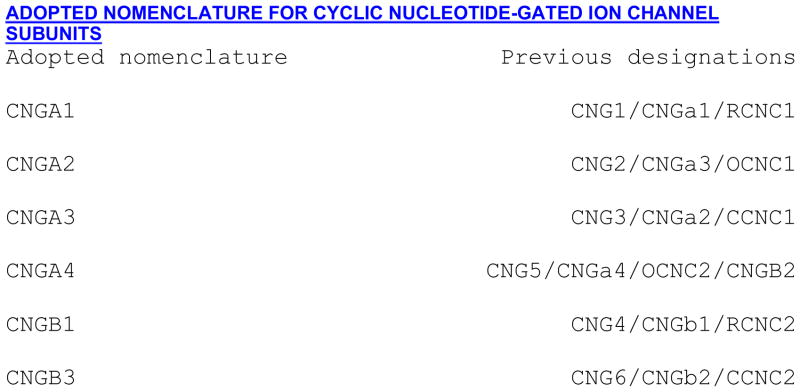Abstract
Presents the nomenclature for ion channel subunits. Role of ion channels in the mediation of visual and olfactory signal transduction; Expression of ion channels in cell types and tissues; Assessment on the nucleotide sensitivity, ion conductance and calcium modulation in heteromers.
Cyclic nucleotide--gated (activated) ion channels are most well known for mediating visual and olfactory signal transductions, but they are also expressed in other cell types and tissues. In native tissues, these channels are heteromultimers, with different heteromers showing distinct nucleotide sensitivity, ion conductance (selectivity), and Ca2+ modulation.
Molecular cloning and genome sequencing efforts have revealed the presence of six genes coding for subunits of cyclic nucleotide-gated channels in human and mouse. The initial isolation and functional characterization of these subunits by different laboratories have led to a confusing and occasionally contradictory nomenclature for describing members of this gene family. To make future work on these channels more easily understood, a group of us engaged in the study of these channels have agreed to adopt a common nomenclature.
The adopted nomenclature (see the table) for these channel subunits recognizes two phylogenetically distinct subfamilies, CNGA and CNGB, defined by their sequence relationships illustrated in the figure. The members in each subfamily are now numbered to retain as much similarity as possible to previous identifiers. However, notably, the OCNC2/CNGB2/CNG5 subunit is now identified as CNGA4, to convey the phylogenetic relationship between this gene and others of the CNGA subfamily. In the CNGB subfamily, the member expressed in rod photoreceptors, olfactory neurons and other tissues is designated CNGB1, whereas that found in cone photoreceptors and possibly other tissues is CNGB3. In our current nomenclature, the CNGB2 designation is no longer used.
This nomenclature is used in two reports in this issue and will be adopted in future publications by the undersigned investigators.
DIAGRAM.
A phylogenetic tree of the different subunits of cyclic nucleotide-gated ion channels.
Contributor Information
Jonathan Bradley, Howard Hughes Medical Institute (HHMI), Department of Neuroscience, Johns Hopkins University School of Medicine, Baltimore, MD 21205, USA..
Stephan Frings, Forschungszentrum Julich, Leo-Brandt-Strasse, Julich, 52425, Germany.
King-Wai Yau, Howard Hughes Medical Institute (HHMI), Department of Neuroscience, Johns Hopkins University School of Medicine, Baltimore, MD 21205, USA..
Randall Reed, Howard Hughes Medical Institute (HHMI), Department of Neuroscience, Johns Hopkins University School of Medicine, Baltimore, MD 21205, USA. Department of Molecular Biology and Genetics, Johns Hopkins University School of Medicine, Baltimore, MD 21205, USA.



